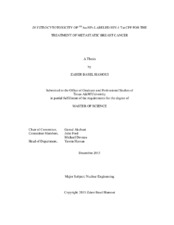| dc.contributor.advisor | Akabani, Gamal | |
| dc.creator | Hamoui, Zaher Basel | |
| dc.date.accessioned | 2016-04-06T16:36:58Z | |
| dc.date.available | 2017-12-01T06:36:14Z | |
| dc.date.created | 2015-12 | |
| dc.date.issued | 2015-11-30 | |
| dc.date.submitted | December 2015 | |
| dc.identifier.uri | https://hdl.handle.net/1969.1/156248 | |
| dc.description.abstract | The present research advances the area of targeted radionuclide therapy (TRT) by using nanoparticles as intrinsic carriers of radionuclides. In here we proposed the use of nuclear nanotechnologies where nanoparticle cores serve as super-carriers of radionuclides, potentially yielding new endo-radiotherapy agents with a higher safety and efficacy profile than those currently used in TRT. We studied a new original concept in TRT by introducing radioactive gold nanoparticles as carriers of the therapeutic payload while increasing the number of radioactive atoms per tumor cell. By separating the radionuclide from the targeting agent, it was possible to avoid the severe effects of radiolysis in molecular decomposition of the targeting agent, which is currently a limiting factor in TRT. We studied under this paradigm the beta-particle emitter 198Au (t1/2 = 2.69 d).
Using radioactive gold Au-198 (t1/2 = 2.69 d) as a therapeutic load and the cationic cell penetrating peptide (CPP) HIV-1 Tat as a targeting agent, we developed the 198Au-AuNP HIV-1 Tat as a therapeutic strategy for the treatment of breast cancer metastases. The breast cancer cell line SKBr-3 was used to test the cytotoxicity of 198Au-AuNP HIV-1 Tat with different activity concentrations for an incubation time of 12 hours. The Real Time Cell Analyzer (RTCA) was used to quantitate the cell growth or delay as a function of time. When compared to controls, a delay in cell growth was observed for wells that were administered an activity of 1000 and 1500 kBq whereas no significant changes were observed for 50, 100 and 500 kBq. The effect of functionalized 198AuNP-HIV1-Tat was observed to have a small effect in cell growth when compared with 198AuNP alone.
Moreover, cell growth delay was compared with that obtained using external beam radiation therapy (2 Gy) and the chemotherapy agent doxorubicin. Results indicated that 198Au-AuNP HIV-1 Tat at 5000 kBq was similar in toxicity to external beam therapy and lower than doxorubicin. We predict the use of cell penetrating peptides in combination with intrinsically radioactive nanoparticles as a new strategy against metastatic breast cancer. | en |
| dc.format.mimetype | application/pdf | |
| dc.language.iso | en | |
| dc.subject | Nuclear Nanotechnology | en |
| dc.subject | Targeted Radionuclide Therapy Nanotechnology | en |
| dc.subject | Metastatic Cancer | en |
| dc.subject | | en |
| dc.title | In Vitro Cytotoxicity of 198Au-NPs Labeled HIV-1 Tat CPP for the Treatment of Metastatic Breast Cancer | en |
| dc.type | Thesis | en |
| thesis.degree.department | Nuclear Engineering | en |
| thesis.degree.discipline | Nuclear Engineering | en |
| thesis.degree.grantor | Texas A & M University | en |
| thesis.degree.name | Master of Science | en |
| thesis.degree.level | Masters | en |
| dc.contributor.committeeMember | Ford, John | |
| dc.contributor.committeeMember | Deveau, Michael | |
| dc.type.material | text | en |
| dc.date.updated | 2016-04-06T16:36:58Z | |
| local.embargo.terms | 2017-12-01 | |
| local.etdauthor.orcid | 0000-0001-9677-9220 | |


